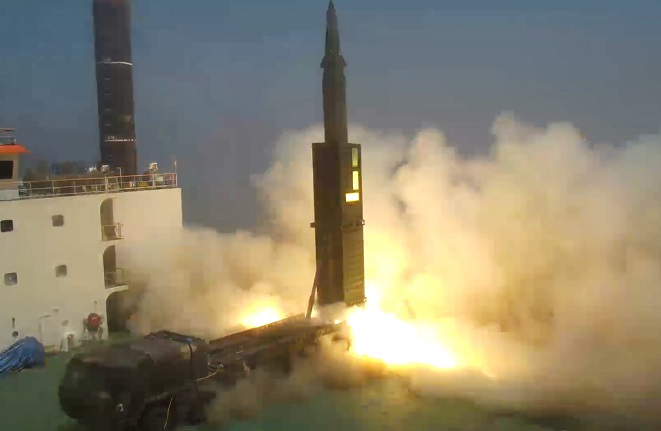
In this file photo, taken June 23, 2017, and provided by the defense ministry, Hyunmoo-2, a new home-grown ballistic missile with a range of 800 kilometers, is test-fired from a mobile launch pad at a test site of the Agency for Defense Development in Anheung, 200 kilometers southwest of Seoul, with President Moon Jae-in on hand. (Yonhap)
SEOUL, Sept. 2 (Korea Bizwire) — South Korea has been developing a massive ballistic missile as powerful as a tactical nuclear weapon, sources said Thursday, after the full lifting of U.S.-imposed restrictions on missile development.
The surface-to-surface missile, which can carry a warhead of up to 3 tons with a flight range of 350-400 kilometers, is in the last stage of development and the timing of its deployment will be determined after several test-firings, according to the sources.
Unveiling its defense blueprint for 2022-2026 earlier in the day, the defense ministry vowed to develop new missiles “with significantly enhanced destructive power,” deploy new interceptors against long-range artillery threats and upgrade the Patriot system.
That suggests the new ballistic missile could be put into operation before 2026.
The envisioned missile is designed to destroy underground missile facilities and bases by penetrating underground tunnels so as to effectively nullify nuclear and intercontinental ballistic missiles (ICBMs) ahead of their launches.
They can also reach all areas of North Korea if fired from around the inter-Korean border, the sources said.
Last year, South Korea successfully developed the ground-to-ground Hyunmoo-4 missile, which has a range of up to 800 km and is capable of carrying a warhead weighing as much as 2 tons.
“We will develop stronger, longer-range and more precise missiles so as to exercise deterrence and achieve security and peace on the Korean Peninsula,” the ministry said in a release.
The comprehensive mid-term defense plan calls for spending 315.2 trillion won (US$273 billion), a 5.8 percent on-year hike on average, over the next five years.
Of the total, 106.7 trillion won was allocated for improving defense capabilities, while the remaining 208.5 trillion won was set aside for force management, according to the ministry.
The move came after the recent lifting of U.S. curbs on the country’s missile development.
In May, Seoul and Washington agreed to lift the “missile guidelines” restrictions that had barred South Korea from developing or possessing ballistic missiles with a maximum range greater than 800 kilometers.
“Following the termination of the guidelines, we will exercise deterrence against potential threats and improve strike capabilities against main targets,” the ministry said, vowing to deploy various surface-to-surface and ship-to-surface missiles with enhanced destructive power.

This file photo, taken Aug. 19, 2021, shows military vehicles during Army training in the northeastern county of Inje. (Yonhap)
North Korea continues to improve its nuclear and missile capabilities amid stalled denuclearization talks with the United States.
On Friday, an International Atomic Energy Agency report said it has detected “deeply troubling” indications that a key nuclear reactor at the North’s main Yongbyon complex has been in operation since July.
“In order to shut out provocations at a long distance, we will sharply increase the number of interceptors targeting mid- and long-range missiles,” the ministry said, referring to its push to develop its own interceptor system like Israel’s Iron Dome.
To better detect such threats across the Korean Peninsula, the military will deploy additional missile early warning radar systems and strengthen its surveillance capabilities, it said.
South Korea is also pushing to expand its presence in the space sector with an eye to deploy a new radar system to monitor space objects by the early 2030s.
Other space projects include an envisioned deployment of a military surveillance satellite and the development of ultra small-sized satellites.
For the Navy, the country will build more 3,000-ton or larger submarines and replace aging frigates with new ones with improved operational and combat capabilities, the ministry said.
The Navy recently received the country’s first 3,000-ton-class indigenous submarine capable of firing submarine-launched ballistic missiles (SLBMs).
As part of efforts to enhance the country’s defense technology, the ministry will increase the research and development budget from 4.3 trillion won this year to 7.1 trillion won in 2026.
Of the total, at least 80 percent will be spent domestically to support the local defense industry, it said.
To counter nontraditional security threats such as COVID-19, the ministry plans to establish an infectious disease research center under the military’s medical research institute by next year and expand the number of medical personnel.
The ministry also said it will push to raise soldiers’ average daily meal cost from 11,000 won in 2022 to 15,000 won in 2024, after coming under criticism over service members’ poor living conditions.
The monthly wage for rank-and-file soldiers will also increase, with an Army sergeant’s salary to reach 1 million won by 2026 from the current 608,500 won, it said.
(Yonhap)






